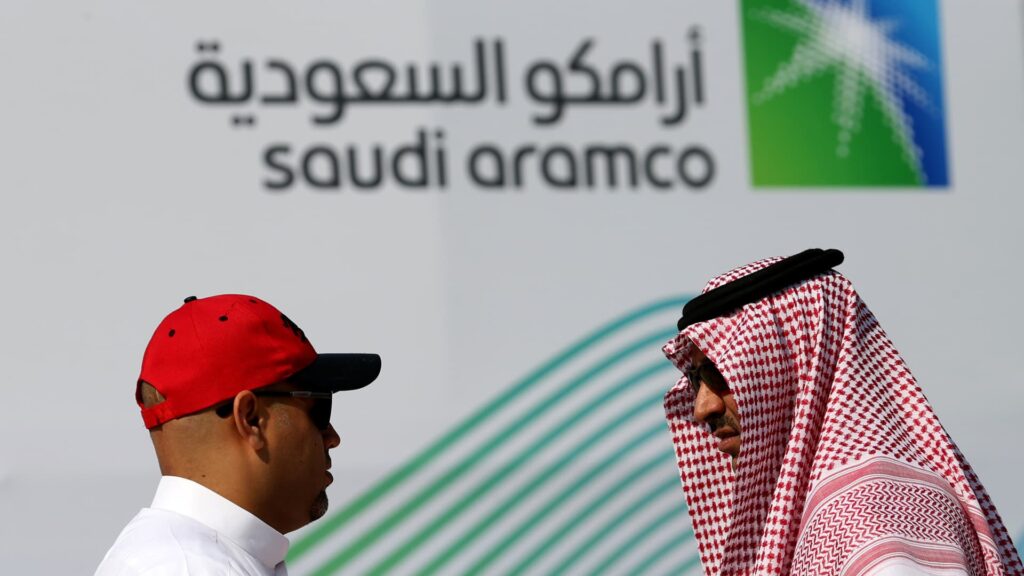Logo of Aramco, officially the Saudi Arabian Oil Group, Saudi petroleum and natural gas company, seen on the second day of the 24th World Petroleum Congress at the Big 4 Building at Stampede Park, on September 18, 2023, in Calgary, Canada.
Artur Widak | Nurphoto | Getty Images
Saudi Aramco on Tuesday posted a drop in second-quarter revenues, citing lower crude oil and refined chemical products prices that were only partially offset by higher traded volumes.
The world’s largest oil company declared an adjusted net income of 92.04 billion Saudi riyal ($24.5 billion) over the three months to the end of June. The result compares with a forecast of adjusted net income of $23.7 billion, according to an analyst survey estimate supplied by the company.
Second-quarter revenues dropped to 378.83 billion Saudi riyals from 425.71 billion Saudi riyal in the same period of the previous year. The results marked ten quarters in a row of declining profits.
“Market fundamentals remain strong and we anticipate oil demand in the second half of 2025 to be more than two million barrels per day higher than the first half,” Aramco CEO Amin Nasser said in a Tuesday statement accompanying the results.
Capital expenditure picked up slightly to 46.2 billion Saudi riyal in the June quarter, up from 45.5 billion Saudi riyal in the same period a year prior.
In a call with journalists, Nasser outlined plans for further increased capital expenditure despite the fall in revenues.
“We always look at potential to improve efficiency in our spending building and flexibility and discipline, and this is embedded in our planning and capital discipline,” the CEO said. “We will continue to monitor market conditions, but we maintain our guidance for the year 2025, of $52 to $58 billion.”
Some analysts see this guidance as overly optimistic.
“An in-line set of results this morning from Aramco, with sequentially weaker upstream earnings offset by a recovery in refining results,” RBC analysts said in a note following the results. “With $25.5bn of capital investments in the first half of 2025, Aramco appears to be running lower than its guidance of $52-58bn for the full year. While spending typically picks up in the second half of the year, we think full year capex could come in towards the lower end of its guided range, subject to acquisitions.”
Crude prices have stayed depressed over the course of the year, barring a brief second-quarter flare-up sparked by Israel-Iran tensions. Futures have been under pressure from an uncertain outlook for demand, exacerbated since April by the rollout of Washington’s wide-spanning tariffs. The protectionist trade measures muddy the picture for growth in the world’s largest economy and the future of the U.S. dollar, which denominates most commodities — including crude oil.
Aramco CFO Ziad Al-Murshed, also speaking on the press call, stressed the company’s efforts to lower costs.
“Across our upstream and across our downstream, we’re going through transformations that are not only focused on cost cutting, but cost cutting is the major component of it,” Al-Murshed said. “So every asset that we have across our upstream portfolio and every asset that we have across our downstream portfolio has been undergoing for the past couple of years, these transformational initiatives, and a lot of it is focused on cutting costs.”

Aramco’s income is set to see a boost from higher output, after Saudi Arabia – and seven other OPEC and non-OPEC partners — complete unwinding 2.2 million barrels per day of voluntary cuts through a last tranche in September. Saudi Arabia most recently produced 9.356 million barrels per day in June, according to independent analyst estimates compiled in OPEC’s Monthly Oil Market Report.
Asked about the OPEC+ actions, Nasser said, “I’m not going to comment on OPEC’s policy, but the impact on Saudi Aramco, if you look at up to September, you see 1 million barrels of the growth in our production as a result of that.”
The company is also focusing heavily on its gas production, aiming for a more than 60% increase by 2030 compared to baseline 2021 levels. The development of Saudi Arabia’s Jafurah gas field is expected to be a major part of that.
That 60% increase goal “is on track because it will give us a lot of opportunity to maximize production of our gas resources the kingdom, and we have a lock-in demand here in the kingdom for this additional gas that we are making more upstream, in addition to availing placement for our value to our liquid chemical investment,” Nasser said. Gas demand is expected to pick up significantly in 2026, according to the International Energy Agency.
“So we are capturing a lot of opportunities, and a lot of opportunities become much better in a down cycle,” the CEO said.
Aramco has increasingly tapped debt markets, with two issuances totalling $9 billion in the second half of 2024 and a three-part bond sale of $5 billion this year. The company’s gearing ratio went up to 6.5% as of June 30, 2025, compared to 5.3% as at March 31, 2025.
Front of mind for investors is the dividend policy at Aramco, which in March slashed investor returns for 2025 to $85.4 billion — down sharply from the $124.2 billion of 2024 — after a first-quarter decline in net profits. Aramco declared a base dividend of $21.1 billion and a performance-linked dividend of $0.2 billion in the third quarter.
The company’s dividend yield stood at 5.5% as of Monday, still ahead of U.S. industry peer Exxon Mobil‘s 3.6% and Chevron‘s 4.5%, according to FactSet data.
Aramco’s payouts ripple sharply into the budget of Saudi Arabia, which has been juggling diversifying its economy away from oil reliance under Crown Prince Mohammed bin Salman’s signature Vision 2030 program. Saudi Arabia’s gross domestic product expanded by 3.9% in the second quarter, boosted by non-oil activities.

